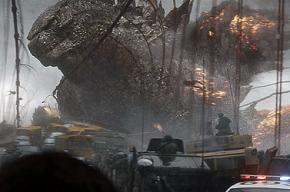King of the monsters?
asks whether the new Godzilla movie lives up to all the hype.
Warning: This review contains spoilers.
JOHN CARPENTER, the director of The Thing, once famously stated, "Monsters in movies are us, always us, one way or the other. They're us with hats on."
"Kaiju" (literally "strange creature" in Japanese) are perhaps the most iconic expression of this. From the time Godzilla--or "Gojira" (a combination of the Japanese words for "gorilla" and "whale")--first rose out of the ocean to stomp on Tokyo in Ishiro Honda's 1954 movie, the monster has served as a not-so-subtle metaphor about the horrors of atomic war.
References to the atomic horrors of Hiroshima and Nagasaki are prominent in the original Japanese film. Japanese audiences in 1954 watching Gojira and seeing images of fleeing refugees and fires, explosions and panic, would have had the real-life experiences of the devastation of Hiroshima and Nagasaki to compare. As Peter Wynn Kirby explained in the New York Times in 2011, "Far from the heavily edited and jingoistic, shoot'em-up, stomp'em-down flick that moviegoers saw in the United States, Japanese audiences reportedly watched Gojira in somber silence, broken by periodic weeping."

Also present in the minds of the audience at Gojira's November 1954 opening was the horror that befell the Daigo Fukuryu Maru ("Lucky Dragon 5")--a Japanese fishing boat whose crew was poisoned with radiation in March 1954 after being caught in the fallout from a 15-megaton H-bomb the U.S. detonated near Bikini Atoll. Six crew later died, and more than 400,000 Japanese citizens turned out for the funeral of the ship's radio operator, Aikichi Kuboyama, that year.
In the original film, early scenes in which Gojira first rises from the sea directly invoke this nuclear menace. As Tim Martin describes the original film in the Telegraph:
Thudding drumbeats and unearthly howls accompany the stark opening titles, before the scene changes to the deck of a fishing boat in the Pacific, where the crew are relaxing, chatting and playing guitar. The ocean begins to boil. The men are blinded and burnt as they flee in terror. Tapping out his desperate SOS below decks, the ship's radio operator is the first to die. Once again, Gojira suggested, the Japanese people was being attacked in its homeland by history's greatest superweapon.
At another point in the 1954 film, a woman on a train complains, "First contaminated tuna...and now Godzilla." (Following the detonation of the U.S. bomb in Bikini Atoll, the Japanese tuna market bottomed out as a result of radiation contamination, and the Emperor Hirohito was said to have removed seafood from his diet as a result.)
For director Ishiro Honda and producer Tomoyuki Tanaka, Gojira was meant both as an homage to great Hollywood monsters in movies like 1933's King Kong, as well as an explicit warning about nuclear dangers.
Tanaka later commented that the allegory of the film was that "Mankind had created the Bomb, and now nature was going to take revenge on mankind."
WHEN IT opened in Japan, Gojira was the most expensive movie to have been made in the country--and it shattered box office records. Ever since, in over 50 movies--and with the creation of hoardes of kaiju allies and enemies from Mothra to Ghidorah (the three-headed monster) to Mechagodzilla (a giant robo-Godzilla controlled by evil aliens)--Godzilla has been presented as both foe and friend to the Japanese people, reflecting his shifting status from monstrous parable to pop-culture icon in the country, in movies that run the gamut from the interesting to the ridiculous (but mainly ridiculous).
As science fiction website IO9's Annalee Newitz recently commented:
In his time, Godzilla has represented nuclear bombs, natural disasters, military science run amok, and genetic experiments gone wrong. He's fought aliens, terrorists, natural forces, other monsters, and time travelers who wanted to undermine Japan's economic power. After 50 years, Godzilla was no longer truly a friend to Japan, nor to humanity. But somehow humanity came up with weapons--including other monsters--to contain him.
It's too bad then that with such meat to work with, the newest, Hollywood-produced Godzilla misses living up to its full potential. The story that is, not the monster.
Don't get me wrong--the latest version of the monster is indeed incredible to behold, a behemoth of special effects that lives up to the hype and may alone be worth the price of a 3-D ticket. Wisely, director Gareth Edwards takes a "tell don't show" approach with the monster until well into the film's second half, revealing just tantalizing glimpses of the kaiju's enormity to the audience early on. (One scene, in which a small glimpse of Godzilla's back is seen wending its way under naval vessels as it heads toward the San Francisco Bay, called to mind Jaws: "You're going to need a bigger boat.")
Opening in 1999 in the fictional Japanese city of Janjira, the film introduces us to nuclear engineer Joe Brody (Bryan Cranston) and wife Sandra (Juliette Binoche). Before Brody can even properly raise the alarm about strange new seismic activity he's been noticing, the nuclear plant is destroyed and the local populace evacuated, in a clear nod to the Fukushima Daiichi meltdown in 2011.
Fifteen years later, the action picks up in modern-day Janjira, as Brody's now-grown son Ford (Aaron Taylor-Johnson), a naval officer just returned from combat duty, tries in vain to talk his father out of his idea that officials are hiding a major secret. Turns out that Joe Brody is right, of course (and Cranston has some fun doing "middle-aged white guy rage" as only he can), but it's too late.
The "massive unidentified terrestrial organism" (or, MUTO) that officials have been keeping from the public has finished sucking the plant's nuclear reactors dry of its radioactive "food," and the creature has awakened to wreak havoc as it makes its way toward an egg-carrying mate that has lain long-dormant in the Nevada desert.
WHAT FOLLOWS is primarily an action thriller--monsters fighting and the military efforts to stop them. This action is interspersed with shots of "serious-looking people" in small rooms, including scientist Dr. Ishiro Serizawa (Ken Watanabe) and Admiral William Stenz (David Strathairn), debating how best to prevent the MUTOs from destroying large swaths of the U.S. even as Godzilla, whose existence has been known to the military since 1954, begins its own lumbering rise from the depths of the Pacific.
What happens next is no surprise--the military advocates the use of nuclear weapons as bait for the MUTOs while Serizawa warns against such plans, arguing that the military should let nature (Godzilla) take its course.
Guess which one is proven right?
Indeed, Serizawa becomes the "Official Scientific Voice of Reason" (TM) common in such movies, dramatically producing his father's pocket watch--stopped at the precise moment of the atomic bombing of Hiroshima--to make the point about the potential dangers of the military's plan. It's the most overt warning in the film about the dangers of atomic weaponry.
Watanabe's role as Dr. Serizawa is a nod to the 1954 film's Dr. Serizawa, an arrogant researcher who sacrifices himself at the end of the film while using his work to kill Gojira--and simultaneously preventing the destructive nature of his work from being replicated in the future. But, that film warned us, "If we keep on conducting nuclear tests, it's possible that another Godzilla might appear somewhere in the world, again."
Unfortunately, the great Watanabe here is reduced to delivering pat one-liners like, "The arrogance of man is in thinking nature is in our control and not the other way around." Oddly, the film glosses over the fact that this new Dr. Serizawa works for a company, Monarch, that has supposedly known about the existence of the kaiju for 60 years but has kept that knowledge from the public. (And wouldn't knowing that there are giant prehistoric monsters who feed off radiation be something that the global public might want to know about when deciding whether or not to, oh, build nuclear plants like the one the film opens on?)
In fact, Edwards' film actually undercuts some of the strength of the anti-nuclear metaphor of the original. Here, we are informed that the 1954 Bikini Atoll bombing wasn't part of the nuclear arms race, but a joint effort of the world's governments to kill Godzilla the first time he rose. And Serizawa's plan to let Godzilla take care of the MUTOs seems hardly less dangerous than trying to use nukes against them.
In an ironic twist, the U.S. Navy participated in the making of Edwards' film--and continues to argue for the use of nuclear power in its operations. As Navy Secretary Ray Mabus told U.S. News and World Report at a recent screening of the movie, "What the Navy has done is proved for 70 years that nuclear energy transportation--which we pioneered--is very safe, very reliable."
Beyond the clumsiness of the film's nuclear politics, it relies on just a few too many coincidences and easy outs--like the fact that our hero just happens to be Naval lieutenant just back from a tour of duty whose expertise is in ordnance disposal (which comes in handy when you might have to deal with a nuclear warhead!)--and a few too many clichéd shots of the awe-struck faces of children witnessing disaster.
None of this makes Godzilla an awful movie--just one whose plot holes and failure to make use of its excellent cast keep it from being a truly epic summer blockbuster.
So if you want to be wowed by some very cool monsters and kaiju battle scenes, overlook the plot and give the newest Godzilla a shot. But then be sure to watch the original 1954 Japanese film (not the American reshoot starring Raymond Burr) and remember, as Annalee Newitz writes, that "the greatest kaiju who ever lived will never truly go away. As long as we face incomprehensibly huge disasters, we will need a metaphor as big as Godzilla to bring them to life."


